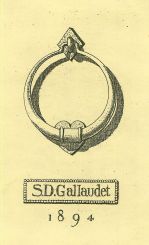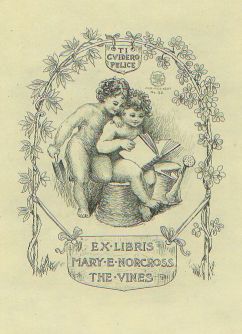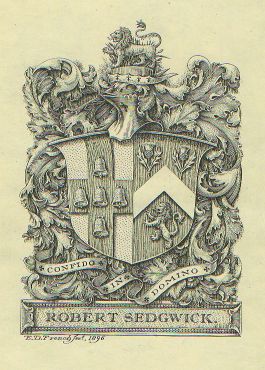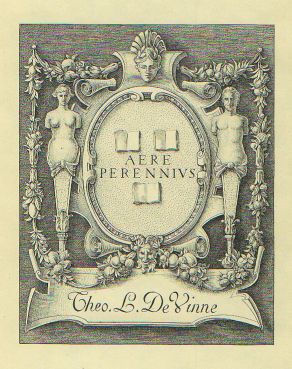America continThe plate of John Vassall, who was so rich a loyalist and who died in England, whose mansion-house at Cambridge became the headquarters of General Washington, and subsequently the home of the poet Longfellow (who himself used a modest bookplate with a Latin inscription), is interesting in itself as well as on account of its owner; for it may with considerable certainty be ascribed to Hurd, which fact is interesting as showing the willingness of this wealthy Britisher to employ an American engraver. The plates of the Vaughans, too, are interesting as being of a wealthy family and a generous one, Benjamin giving his library to Bowdoin College. The Winthrops, too, used book-plates, and one very old one which was used by John Winthrop, who was born in 1681 and who died in England in 1747, is known. Old Thomas Coram, who in 1694 was a shipwright in Taunton, Mass., and who gave land and books for a library in that town, used £ book-plate which shows his crest and his name below it enclosed within an oval wreath of vines. The plate is rather crude in design and execution, as befits its earlv date. He it was who established the Foundling Hospital near London, where one hundred and seventeen infants were cared for, it is said, on the first day it was opened, and where Handel used to play annually. The red-coated boys and the white-capped girls may still be seen playing in the enclosure, and the visitor may see within the buildings some very interesting relics of the bygone glory of the place, — among other things, paintings by Hogarth, Kneller, and West; a bust by Roubillac; and the pulpit in which Laurence Sterne preached. Massachusetts, too, had many libraries which used book-plates which are worthy of notice and which the collector will prize. The American Academy of Arts and Sciences used an elaborate plate engraved by Callender, the Boston Architectural Library, Boston Circulating Shakespeare Library, Boston Social Law Library, Bowdoin College, Boylston Medical Library, Dartmouth College and its Society of Social Friends, the Dedham Scripture Study Society, Harvard College and the Hastv Pudding and Porcellian societies, the Haverhill Library, Massachusetts Historical Society, Newburyport Athenaeum, and the Worcester Circulating Library are among these.
As one glances over the plates of Massachusetts, it may occur to him that their owners lived with less repose than did the New Yorkers or the Philadelphians. There was money and culture, but there was not the air of leisure about the life of the inhabitants of this Northern state that impresses one in turning over the records of the more southern colonies. There must have been in their blood some inclination to take things seriously, to give themselves to unremitting labor, and an intense love of country and liberty. These things worked together to prevent the full enjoyment of ease and luxury in so general and widespread a fashion as was observable among their Southern neighbors.
It will occur to some, undoubtedly, that the early engravers offer a most inviting field for investigation, and so they do; but, unfortunately, very little can be found in old records and books concerning them. The ” interview ” was not then so elaboratean affair as it is to-day, and the lives of these humble artisans, with one or two exceptions, have not been made the subject of magazine articles or the longer biography which would fill a book. In New England there were Abel Bowen, Joseph Callender, Nathaniel Dearborn, John Mason Furnass, S. Harrris, Samuel Hill, Nathaniel Hurd, Paul Revere, Thomas Johnson, and James Turner, all of Boston; Amos Doolittle and Gideon Fairman, of Connecticut; and Edward and Elisha Gallaudet, Abraham Godwin, Charles P. Harrison, the Mavericks, Alexander Anderson, and Charles P. Rollinson, in New York; with John Boyd, Henry Dawkins, Francis Kearney, J. Smithers, T. Sparrow, James Thackara, James Trenchard, and John Vallance in the cities farther south. Here is a handful of early engravers whom it would be most interesting to know more of than we now do, and all additions to our knowledge of them is most welcome.
Before taking leave of the early plates of our country, mention should be made of a few very excellent examples of engraving which the book-owners of the West Indies used in their volumes. Among these are Charles Ashwell of Grenada; William Assheton, Provost Marshal of Barbadoes; Joseph Beete of Demerary; William Blanc of Dominica, who was educated at the Middle Temple; Jonathan Blenman, Attorney-General and Judge of the Admiralty in Barbadoes; Francis Byam of the island of Antigua; Donald Campbell of Jamaica; Bryan Edwards of Greenwich Park, Jamaica, who was not only a very wealthy merchant, but a historian of ability; Samuel Heming of the parish of Santa Anna in Jamaica; Robert Hunter, who was sometime Governor of Jamaica, in 1728 the Bishop of Jamaica; William George Knox of the island of Trinidad; Charles Pinfold, Governor of Barbadoes; Eben Robertson of Kingston, Jamaica, who belonged to that family of Robertsons below whose shield of arms depends the man in chains; Samuel Vaughan, the wealthy planter in Jamaica; and William Williams of Antigua, who had one of the most beautiful plates used in this country, and which was engraved in Paris.
Leaving now the old plates, we turn for a moment to speak of some of the recent examples. No historical memories as yet enrich these plates, but very possibly the collector of the next century will look back to many of them with great delight and find in them many a reason for their preservation; and as generations come and go, the day will probably come when they will be written about as old plates, scarce and valuable. I do not intend here to mention many plates, indeed, only those which are illustrated in this volume, and whose owners have kindly placed their coppers in my hands for this purpose. They have been selected with care and not without good reason.
They represent the newest work of the best engravers of the day. There is just now a very widespread interest in the subject of book-plates; a very general renascence is under way. The book-plate is again coming into use as a useful and charming bit of bookish property. This pleasing fashion, which was at its height about a century ago, is now, after an interval of decline, showing signs of vigorous life. Just as the early use of the book-plate in America was introduced from England, so to-day this revival of interest in the subject follows a similar revival in old England. To the very flourishing Ex Libris Society of London, and all the active members it now numbers, is due this new condition of interest.
In casting about for a design for his book-plate, the American does not feel that need of introducing the shield of arms which the Englishman does. Heraldry is not an American institution, and few are the Americans whose descent from the armorial families of the older countries is such as to permit the use of arms, should the exact letter of the laws of this exact science be applied to them. To the American who is fond of books and history, it will at once occur that a design appropriate to the purpose of the book-plate and indicating, by some of its features, an event of historical importance, either to the individual or the country, can be devised. Many such plates are being engraved to-day, and in them are many bits of history, personal or national, to discover and understand which is the delight of the collector. Among such, three are illustrated in this volume, —the plates of Dr. Walker, of Mrs. Gallaudet, and Mr. Buck.
Dr. George Leon Walker, pastor-emeritus of the old First Church in Hartford, records upon his book-plate an incident in the life of his first ancestor on American soil, —Richard Walker of Saugus (or Lynn), in the year 1632. In the first part of the twenty-fifth chapter of Edward Johnson’s Wonderworking Providence of Sions Saviour in New England, may be found the story the plate commemorates, Lieutenant Walker was out on sentinel duty against the Indians when, in the discharge of his duty, he fired at the savages. The gun burst, a fact which is suggested in the book-plate by the non-belligerent manner in which he holds his disabled “caliver”. Upon examination, it was discovered that the Lieutenant’s coat had been pierced by two arrows, though he himself had escaped injury. This sturdy Puritan was an officer in the little army which went out against the Pequots, became a Captain, in the Massachusetts troop, and was one of the earliest members of the Ancient and Honorable Artillery Company. He died in Lynn at an advanced age, The design which so pleasingly records the hairbreadth escape of the intrepid sentinel was drawn by the wife of Dr. Walker’s son, Professor Williston Walkers and the plate was etched by Hoffman of Rockville, Conn.

The plate of Mrs. Susan Denison Gallaudet of Washington, D.C., which represents an old doorknocker, also refers to a matter of personal history which is of interest. Colonel George Denison, an ancestor in the eighth generation, the builder of a fort at Stonington, Conn., the purpose of which to supply a place of refuge for his family and his neighbors in case of hostilities on the part of the Indians, Some fifty years after the fort was built, a house was erected upon its site, and on its western side shingles were placed which had been previously used on the demolished fort. The old house is standing to-day, or at least it was a dozen years and on its front door is a curious old iron knocker, whose antique appearance caught Mrs. Gallaudet’s attention upon the occasion of a visit to this interesting locality. From the sketch which she then made, several reproductions in brass were formed, which adorn the homes of various members of the family. It occurred to Mrs. Gallaudet that this old knocker would make a fitting emblem for a bookplate, not only on account of its historical and family associations, but also because the knocker at the door of the book makes quite a happy device, and an uncommon one. The plate is etched by Mr. Howard Sill, of the Washington Book-plate Society.

Mr. John H. Buck of New York City, an authority on old plate and stained glass, and the author of a valuable work entitled Old Plate (New York, 1888), uses a book-plate of charming design, which needs a word of explanation to bring out its historic interest. Mr. Buck is by birth a Devonshire man, and his father was, at the time of his birth, the second master of the old school founded by Peter Blundell, and within whose venerable walls, John Ridd, as all who have read Lorna Doone will remember, learned the rudiments.
In his bookplate, Mr. Buck, who is familiar with all the legends of the school and its vicinity, has had pictured the present appearance of this noted school. One who looks for them will find the spot in the walk where the founder’s initials are sunk in big cobblestones, and the triangle upon which John Ridd put up so brave a fight. It will be interesting also to relate that the author of Lorna Doone attended this school at the time when the owner of the plate was born, and that he, with the other scholars, was granted a half-holiday in honor of the occasion. The tall cupola which is seen in the plate once crashed through the roof into the rooms below, narrowly missing putting an end to the little life so famously inder its insecure foundations. The letters P. B. stand for the founder of the school, and the date 1604 records the date of the founding; while in other parts of the frame are disposed the arms of Blundell, the seal of old Tiverton, the arms of the state of New York, and those of the owner. The design has been most successfully engraved by Mr. J. Gill of New York City.
Some book-lovers consider with good reason that the book-plate should record their own personal likes and bents, their own interesting bits of personal history, or even their own features for future, as well as present-day, collectors to prize. Indeed, the portrait plate is altogether too uncommon. Public libraries sometimes commemorate the donor of an alcove by using his features on the book-plate, and now and then one comes across an individual owner who uses a portrait plate. It is a custom that should be encouraged; for as the book-plate is seen to reach its highest type when made to convey some meaning, it surely is fully permissible to have the face and autograph of the bookman on his own plate, which is to mark his own books. Mr. William H. Gaylord, President of that flourishing association of book-lovers, the Rowfant Club of Cleveland, Ohio, uses a plate which not only shows his features, but indicates in no uncertain way his favorite habit of reading in bed. It was the late Eugene Field, in his delightful Love Affairs of a Bibliomaniac, who said, ” I piled at least twenty chosen volumes on the table at the head of my bed, and I dare say it was daylight when I fell asleep,” which he did, with a copy of Villamaria’s fairy stories in his hands. Going on to enlarge upon the delights of reading in bed, the author says : —
“… observation has convinced me that all good and true book-lovers practise the pleasing and improving avocation of reading in bed. Indeed, I fully believe with Judge Methuen that no book can be appreciated until it has been slept with, and dreamed over.”
He goes on to show that Cicero (not Kikero) was a great bed-reader, and he deduces the fact from a quotation in which occurs the word pernoctant.
Mr. Gaylord, in casting about for a subject, decided upon testifying to his personal endorsement of the views of Field and Cicero, and he has shown in his exceedingly interesting plate the attitude beloved of Field and himself, and the words of Cicero by Field believed to prove the attraction this habit of reading in bed had for that worthy orator. Field pictures him unrolling scroll after scroll of his favorite literature, as, propped up on his couch, he only stops to mutter maledictions upon the slave who has let the lamp run low, or has neglected to trim the wick. In his plate, Mr. Gaylord shows that he is his own torch-bearer, and, as one glances about the little nook, its unmistakable snugness and cosiness cannot fail to be apparent. The books of his choice are within reach, the fragrant weed offers its solace, and the black night stays outside the leaded window, peeping through at the flickering flame of the dip.

In the plate of Dr. J. M. Thompson of Boston, Mass., the observer will at once note those accessories which plainly denote the student of medicine, the man devoted to science. Here again is an example of a design which carries with it some indication of the owner’s bent of mind, which is a pleasing thing to do upon the book-plate. This is engraved by Richard Cathie.
Mr. Charles William Sherborn, who is the most celebrated living English engraver, has made many very charming book-plates, and among his many customers have been a very few Americans. Of the few plates Mr. Sherborn has made for our countrymen, one of the most satisfactory is that for Mr. Harris C. Fahnestock of New York City. In this, the spirit of literature stands by the pedestal on which lies the roll about to be written upon, while all about are emblems which indicate the lover of art, of music, and of books. The motto, which in translation reads, ” Among the leaves the fruit,” is one of the most fitting for a book-plate.
In several little etchings, Mr. J. Winfred Spenceley of Boston has shown himself adept at catching the spirit of the book-plate, and of the especially striking ones is that used by Miss M. M. Sands, whose home is by the shores of Pine Lake, Wisconsin, and in which is depicted just a glimpse, not unlikely a favorite view, of the lake through the swaying boughs of an old overhanging pine. In his own plate, Mr. Spenceley has used the heraldic form with chaste and simple ornamentation.
Among the designers, etchers, and engravers of book-plates who have attained especial prominence in this country, are Mr. W. F. Hopson of New Haven, Conn., Mr. Edmund H. Garrett of Winchester, Mass., Mr. Sidney L. Smith of Boston, and Mr. Edwin Davis French of New York City.
Three designs by Mr. Hopson are given here, each one of them of striking interest and eminently suited to the purpose of the book-plate, while well calculated to indicate sufficiently some branch of the owner’s literary interests. In the plate of Mr. Stoddard, the medallion of Napoleon, the rows of well-filled book-shelves, the horse, the dog, and the glimpse of the sea furnish a clue to the varied tastes of the owner; while in the plate of Mrs. Josephine E. S. Porter of Hartford, Conn., the showily dressed dame of bygone years, with the peacock of vanity, will tell to shrewd eyes of the owner’s interest in the costumes of olden days. Indeed, the plate was specially designed to be placed in the owner’s large and valuable collection of books upon the subject of costume. In the plate of the Rev. Stewart Means, Mr. Hopson shows the study of the rector of St. John’s Church in New Haven with the rolling clouds now and then disclosing sufficient moonlight to enable one to see the church itself. In the lower panel is the motto, which in translation would say, ” Trust in the Lord and abide in thy drudgery.” The books of the student are seen, and in the procession just below the book-shelf the designer has indicated the march of the centuries before the eye and mind of the student. First, is the primitive man, then Roman soldiers, a monk, a pope, Luther the reformer, Queen Elizabeth with her cavaliers. Puritans, Indians, and so on to the slave, and the bicycle rider of the end of this century. A most delightful moonlight effect is diffused over the whole plate.

Mr. Garrett is very dainty in his imagination, very pleasing in his designing, and very effective in his manner of etching his designs. In the two plates given here, these qualities are well indicated. In the plate of Miss Wheeler of Medford, Mass., the love of books of artistic merit is evidenced,

while in the plate of Miss Norcross of Winchester, Mass., one reads that the owner of the plate is fond of flowers, and that she has a library of books devoted to horticulture.
The two charming plates designed and etched by Mr. Sidney L. Smith of Boston, show a really delightful use of the emblems of the book-lover and the student. Mr. Chase is a book-collector of Boston, and this effective bit of designing and etching is a most pleasing bit with which to prove his ownership in many choice volumes.

Rev. J. B. Troy is a book-loving priest of the Roman Catholic Church, living at Norwood, Mass., and in his plate are incorporated not only the book-lover’s emblems, but those of the church as well. The radiant design upon the window will explain itself to the close observer as indicating the life of faith, the need of love, and the surety of reward, as well as the almighty power of the Most High. On the table lie the biretta and the stole, indicating the practical side of the owner’s life, while the globe, the lilies, and the skull are adjuncts of easily understood meanings. The reverend gentleman is a devoted book-collector, and has now a library of over three thousand volumes, embracing all branches of learning, science, art, and fiction.

Of the three plates by Mr. Edwin Davis French of New York City which are here represented, but one is his own design, and that is the plate of Mr. Robert Sedgwick of the same city. While the heraldic form is not very generally used in this country, there are, as has been said, a few who have an unquestioned right to show armorial bearings, and among these are Mr. Sedgwick and his wife, whose arms (Renwick) are impaled with his. In the designing of heraldic plates, it is more than a knack that enables the engraver to relieve the plate from being simply and barely armorial, and yet to keep his ornamentation from overburdening the design. This plate is most successful in this very particular, and furnishes a most rich and handsome appearance.
The plate of Mr. Charles H. Taylor, Jr., of the Boston Globe, while engraved by Mr. French, is after a design by Mr. E. B. Bird, a widely known artist of the same city. The silhouette landscape at the top represents Copley Square,—a typical Boston view, — and, as Mr. Taylor is especially interested in books on Boston, on nautical matters, and those relating to ” the art preservative of arts,” the special fitness of the hermaphrodite brig, the old Franklin press, and the well-bound books will be appreciated.

The plate of Mr. Theodore L. De Vinne, the famous printer of New York City, was designed by Mr. George Fletcher Babb, the architect, who says of his design that ” the idea is the motto, with the books placed as has been the custom in a cartouche.” The decorative presentment is furthered in all details, and, while the exact purpose of the design may be slight, it has a decidedly sixteenth-century appearance, and will lead the observer at once to think of Plantin and the Elzevirs, of Tory, Wechel, and the Stephens. The caryatides were much used by Christopher Plantin on his title-pages, and in this plate for Mr. De Vinne they are intended to represent History and Prose, while the face at the top is that of Minerva, and at the foot peers Pan. This, too, is engraved by Mr. French.
